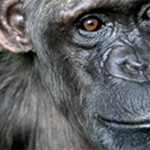Research Projects
Biological and Human Dimensions of Primate Retroviral Transmission
 One of the great enduring mysteries in disease ecology is the timing of the AIDS pandemic. AIDS emerged as a clinical entity in the late 1970s, but HIV-1, the retrovirus that causes pandemic AIDS, entered the human population from wild primates many decades earlier, probably near the turn of the 20th century. Where was HIV during this long interval? We propose a novel ecological model for the delayed emergence of AIDS. Conceptually, in a metapopulation consisting of multiple, loosely interconnected sub-populations, a pathogen could persist at low levels indefinitely through a dynamic balance between localized transmission, localized extinction, and long-distance migration between sub-populations. This situation might accurately describe a network of villages in which population sizes are small and rates of migration are low, as would have been the case in Sub-Saharan Africa over a century ago.
One of the great enduring mysteries in disease ecology is the timing of the AIDS pandemic. AIDS emerged as a clinical entity in the late 1970s, but HIV-1, the retrovirus that causes pandemic AIDS, entered the human population from wild primates many decades earlier, probably near the turn of the 20th century. Where was HIV during this long interval? We propose a novel ecological model for the delayed emergence of AIDS. Conceptually, in a metapopulation consisting of multiple, loosely interconnected sub-populations, a pathogen could persist at low levels indefinitely through a dynamic balance between localized transmission, localized extinction, and long-distance migration between sub-populations. This situation might accurately describe a network of villages in which population sizes are small and rates of migration are low, as would have been the case in Sub-Saharan Africa over a century ago.
We will test our model in a highly relevant non-human primate system. In 2009, my collaborator Tony Goldberg and colleagues documented three simian retroviruses co-circulating in a metapopulation of wild red colobus monkeys (Procolobus rufomitratus) in Kibale National Park, Uganda, where Goldberg and my other collaborator Colin Chapman have conducted research for over two decades. We will collect detailed data on social interactions, demography, health, and infection from animals in a core social group.
We will also study a series of 20 red colobus sub-populations, each inhabiting a separate, isolated forest fragment. Along with collaborator Nelson Ting, we will determine the historical connectivity of these sub-populations using a time series of remotely sensed images of forest cover going back to 1955, as well as using population genetic analyses of hypervariable nuclear DNA markers. We will assess the infection status of each animal over time and use viral molecular data to reconstruct transmission pathways.
Our transmission models will define the necessary conditions for a retrovirus to persist, but they will not be sufficient to explain why a retrovirus might emerge. This is because human social factors ultimately create the conditions that allow zoonotic diseases to be transmitted from animal reservoirs and to spread. We will therefore conduct an integrated analysis of the root eco-social drivers of human-primate contact and zoonotic transmission in this system. We will study social networks to understand how social resources structure key activities relevant to human-primate contact and zoonotic transmission risk, and we will explore knowledge, beliefs, and perceptions of human-primate contact and disease transmission for a broad sample of the population. We will reconcile perceived risk with actual risk through a linked human health survey, diagnostic testing for zoonotic primate retroviruses.
The ultimate product of our research will a data-driven set of transmission models to explain the long-term persistence of retroviruses within a metapopulation of hosts, as well as a linked analysis of how human social factors contribute to zoonotic infection risk in a relevant Sub-Saharan African population. Our study will elucidate not only the origins of HIV/AIDS, but also how early-stage zoonoses in general progress from "smoldering" subclinical infections to full-fledged pandemics.
PI: Jamie Jones
Collaborators: Tony Goldberg, Colin Chapman, Nelson Ting
